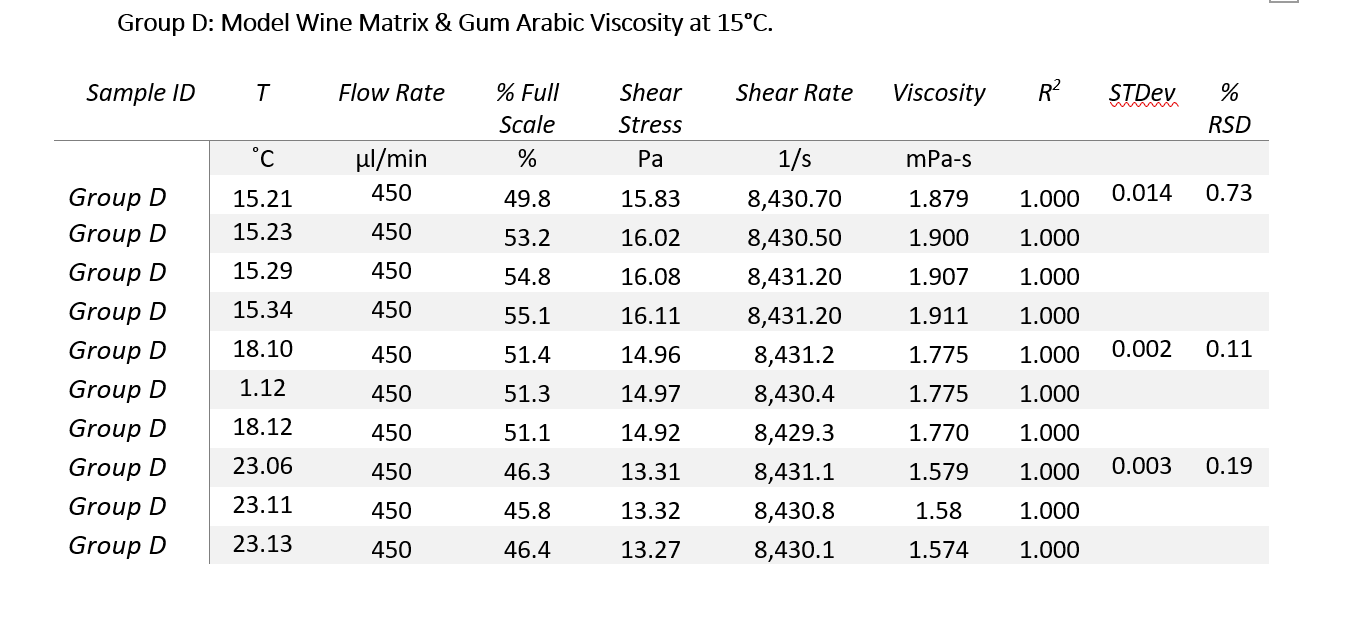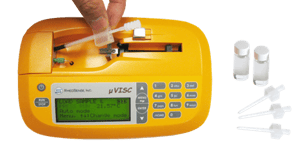Wines are multi-component fluids comprised of water, alcohol (specifically ethyl alcohol), sugar, acid, and phenolic compounds (ex: tannins or vanilla). Each of these components influences fluid viscosity and therefore measuring viscosity can characterize the composition of a different wines. Wine composition is not the only factor that determines the taste or quality. An important aspect to how we process wine is through sensory perception via mouthfeel, which is describes as a "...[Combination] of "appearance, aroma, and taste" (Laguna). Viscosity is also known to contribute to the mouthfeel of wine, which can improve the oenophile’s experience. We are also able to demonstrate a good correlation between alcohol content and viscosity measurements for wines with similar sugar content using the portable, small sample viscometer: microVISC™.
Four wine matrixes with various additives were tested to demonstrate the measurement capabilities and features of microVISC™ system:
- Fast, easy and portable.
- Accurate determination of viscosity (2% of reading).
- Repeatability (0.5% of reading).
The objective of the study was to measure viscosity at 15 °C and 23 °C, taking advantage of the evaporation-free features of VROC® technology. Here is the summary of the results:
- microVISC™ successfully measured dynamic viscosity (η) for four various samples at 15 °C, 18 °C, and 23 °C.
- The samples displays Newtonian behavior (i.e. viscosity is independent of shear rate).
- Presented results are an average of 3 repeats. Accuracy is 2% of reading and repeatability is 0.5% or better.
- An A05 flow cell (50 µm) was used during testing. Lower/Higher shear rates would be accessible with the different chip configurations available for VROC® technology.
- For each solution, we were able to measure samples with about 60 µL maximum for a normal measurement (and no more than 144.8 µL for priming) using microVISC™.
- To improve additional parameters for optimal resolution, we recommend running it in ADVANCED MODE under 400 µL/min and at the functional temperatures of the viscometer TC which is between 18 to 50 °C.
Testing protocol:
- Load sample into a 400 µL disposable pipette. Lowest sample volume used was 52.7 µL and priming sample volume took maximum of 144.8 µL.
- Insert into the microVISC™ system and allow 5 min for temperature stability at 15° C, 18 °C, and 23 °C.
- Run in AUTO mode with microVISC™. Specific shear rates can be set and ran in ADVANCED mode.
- After testing, cleaning is achieved by running 1 pipette of 1% Aquet. Please note that the four samples were not miscible in Ethanol or IPA. Images of miscibility are shown and noted below.


Tabulated Shear Viscosity Results:
Group A: Model Wine Matrix Viscosity at 15°C.

Group B: Model Wine Matrix & Oak Extract Viscosity at 15°C.
 Group C: Model Wine Matrix & Oak Extract Viscosity at 15°C.
Group C: Model Wine Matrix & Oak Extract Viscosity at 15°C.

Group D: Model Wine Matrix & Gum Arabic Viscosity at 15°C.

Written by: Grace Baek, RheoSense Operations Manager


